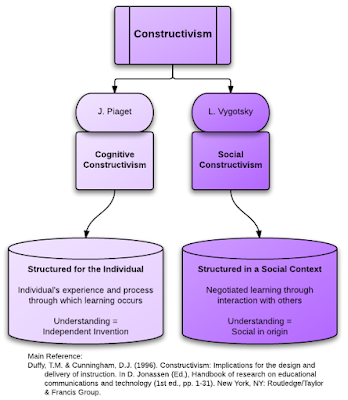Constructivism: Vygotsky’s contributions to the psychology of learning pass considering that development processes and learning have close and complex relationships; this way learning and development are at the base and walk interactively in the educational growth of the subjects. In the case the teaching-learning is not a mere passive transmission of knowledge and cultural knowledge by the adult members of social groups to younger , but do so in a process of active, participatory and constructive assimilation. Therefore requiring dynamic learning is focused on the interaction of individuals in order to promote and generate the construction of knowledge. According with Vygotsky and his sociocultural theory of learning, so the knowledge is not discover, the knowledge builds with the interaction with people, In this sense Vygotsky’s theory gives the teacher a key role in facilitating consider the development of mental structures in the student to be able to build more complex learning therefore the constructivism is the basis for building knowledge in community. It is emphasized and then assesses the importance of social interaction in learning; students learn more effectively when they make cooperatively. Vygotsky’s contributions have great significance for the constructivist theory and achieved that learning is not considered as a single activity and otherwise be understood as a social construction.
Vygotsky's theories stress the fundamental role of social interaction in the development of cognition Vygotsky, 1978), as he believed strongly that community plays a central role in the process of "making meaning."
Vygotsky argued, "Learning is a necessary and universal aspect of the process of developing culturally organized, specifically human psychological function" (1978, p. 90). In other words, social learning tends to proceed (i.e. come before) development. So Vygotsky has developed a sociocultural approach to cognitive development., this way Vygotsky places more emphasis on culture affecting/shaping cognitive development; therefore he assumes cognitive development varies across cultures, Vygotsky states cognitive development stems from social interactions from guided learning within the zone of proximal development as children and their partners co-construct knowledge.
Zone of Proximal Development (ZPD) describes the area between a child’s level of independent performance (what he/she can do alone) and the child’s level of assisted performance (what he/she can do with support). Skills and understandings contained within a child’s ZPD are the ones that have not yet emerged but could emerge if the child engaged in interactions with knowledgeable others (peers and adults) or in other supportive contexts (such as make-believe play for preschool children). According to Vygotsky, the most effective instruction is the kind that is aimed not at the child’s level of independent performance but is instead aimed within the ZPD. This instruction does more than increase a child’s repertoire of skills and understandings; it actually produces gains in child development.
To aim instruction at the child’s ZPD, the teacher
needs to know not only what the child’s developmental level is at the time, but
also what skills and concepts will develop next. To know these, the teacher
needs to understand the developmental trajectories for these skills and
concepts. Successful instruction within the child’s ZPD also involves making
sure that the child will be eventually able to function independently at the
same high level at which he or she was previously able to function with adult
assistance. Once this is accomplished, the teacher can start aiming instruction
at the new ZPD.
Even when children have developed new skills and
competencies sufficient to perform a task with adult assistance, it may not
mean that tomorrow they will be ready to perform the task independently. For
most children, the transition from assisted to independent learning is a
gradual process that involves moving from using a great deal of assistance to
slowly taking over until eventually no assistance is needed. To facilitate this
transition, a teacher needs to scaffold student learning by first designing and
then following a plan for providing and withdrawing appropriate amounts of
assistance at appropriate times.
In the Vygotskian approach, instructional strategies
used to scaffold include (but are not limited to) hints, prompts, and cues
given and later removed by the teacher. Scaffolding can also involve
orchestrating social contexts known to support children’s learning, such as
make-believe play or specifically designed group activities. Scaffolding may
also involve introducing children to special tools (such as an alphabet chart)
and behaviors (such as private speech or self-talk) that children can use to
self-assist while mastering a new skill or concept.
more information in http://www.simplypsychology.org/vygotsky.html
more information in http://www.simplypsychology.org/vygotsky.html



http://vocaroo.com/i/s1Lu7J0J0SCl
ResponderEliminar